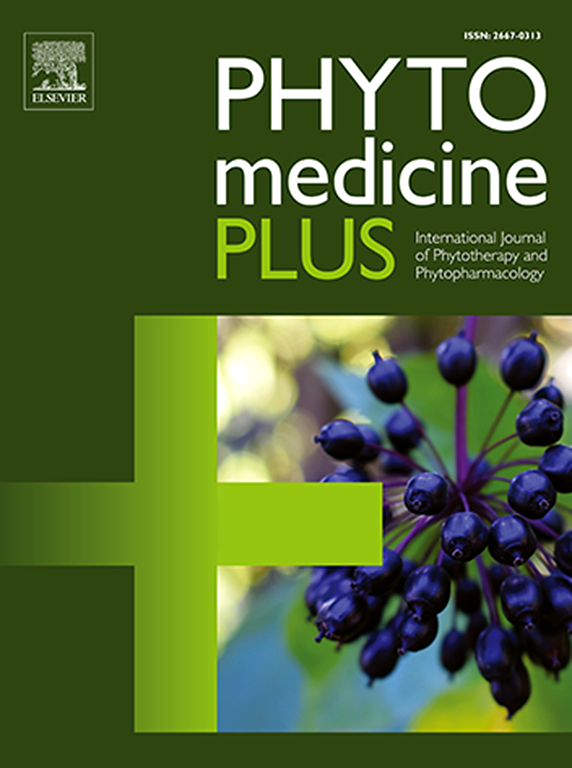Anti-inflammatory effects of Andrographis paniculata (Fah Talai Jone) via TNFα-JNK pathway and bioactive compound identification
Q3 Pharmacology, Toxicology and Pharmaceutics
引用次数: 0
Abstract
Background
Andrographis paniculata (Fah Talai Jone), a widely used medicinal plant in traditional medicine, is known for its anti-inflammatory properties. This study investigates its bioactive compounds and their role in alleviating inflammation through the TNF-α-JNK pathway.
Purpose
The aim of this study was to identify bioactive compounds in A. paniculata extracts and evaluate their anti-inflammatory effects, focusing on the TNF-α-JNK pathway.
Study Design
Experimental research was conducted to assess the antioxidant, cytotoxic and anti-inflammatory properties of both ethanol (APE) and aqueous (APA) extracts of A. paniculata using in vitro methods.
Methods
Ethanol (APE) and aqueous (APA) extracts of A. paniculata were prepared and analyzed for total phenolic and flavonoid content, antioxidant activity, and bioactive compound identification using high-performance liquid chromatography (HPLC). Cytotoxicity was evaluated using the sulforhodamine B assay, and the anti-inflammatory effects were assessed through cellular assays measuring reactive oxygen species (ROS) production and JNK pathway modulation.
Results
HPLC analysis identified andrographolide as the primary bioactive compound in APE (186.6 ± 2.53 µg/mg). APE exhibited higher phenolic (8.66 ± 0.37 mg GAE/g) and flavonoid (156.33 ± 4.76 mg QE/g) content compared to APA. Antioxidant assays revealed IC50 values of 11.14 ± 1.07 µg/ml for APA and 2.29 ± 0.13 µg/ml for APE. Cytotoxicity studies demonstrated that both extracts were non-toxic to lung cells. APE significantly reduced ROS production (68.3 ± 7.64 % at 62.5 µg/ml) and decreased JNK phosphorylation, indicating its anti-inflammatory potential.
Conclusion
Andrographis paniculata, particularly its ethanol extract, exhibits potent antioxidant and anti-inflammatory effects mediated by andrographolide. These findings support its potential as a natural therapeutic agent for managing inflammation.

穿心莲tnf - α- jnk通路的抗炎作用及活性化合物鉴定
穿心莲(andrographis paniculata, Fah Talai Jone)是传统医学中广泛使用的药用植物,以其抗炎特性而闻名。本研究探讨其生物活性成分及其通过TNF-α-JNK通路减轻炎症的作用。目的鉴定荆芥提取物中的生物活性成分并评价其抗炎作用,重点研究TNF-α-JNK通路。研究设计:采用体外实验方法,研究金针叶乙醇提取物(APE)和水提取物(APA)的抗氧化、细胞毒和抗炎作用。方法采用高效液相色谱法(HPLC)对荆芥的乙醇(APE)和水(APA)提取物进行总酚和类黄酮含量、抗氧化活性和生物活性化合物鉴定。采用硫代丹胺B法评估细胞毒性,通过测量活性氧(ROS)产生和JNK通路调节的细胞分析评估抗炎作用。结果经hplc检测,穿心莲内酯为主要活性成分(186.6±2.53µg/mg)。与APA相比,APE具有较高的酚类(8.66±0.37 mg QE/g)和类黄酮(156.33±4.76 mg QE/g)含量。抗氧化实验显示,APA的IC50值为11.14±1.07µg/ml, APE的IC50值为2.29±0.13µg/ml。细胞毒性研究表明,这两种提取物对肺细胞无毒。在62.5µg/ml浓度下,APE显著降低ROS生成(68.3±7.64%),并降低JNK磷酸化,表明其抗炎潜力。结论穿心莲,尤其是穿心莲乙醇提取物,具有由穿心莲内酯介导的抗氧化和抗炎作用。这些发现支持其作为控制炎症的天然治疗剂的潜力。
本文章由计算机程序翻译,如有差异,请以英文原文为准。
求助全文
约1分钟内获得全文
求助全文
来源期刊

Phytomedicine Plus
Medicine-Complementary and Alternative Medicine
CiteScore
3.70
自引率
0.00%
发文量
178
审稿时长
81 days
期刊介绍:
 求助内容:
求助内容: 应助结果提醒方式:
应助结果提醒方式:


